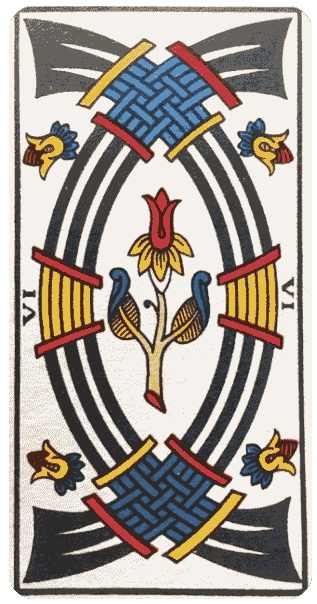synthetic meaning
To achieve the equilibrium of the two ternaries[1], one spiritual and the other material, as well as the activity resulting from their polarization, the Six of Swords is represented entirely by six stylized swords, symbolizing, consequently, the every more subtle currents of the subconscious. They surround a flowering branch whose five petals of yellow color with a red flower rest on a white base. This signifies an attempt to bring mind into balance with the material world through a state of internal consciousness which has already evolved.
analytic meaning
In a circle, the center is regarded as an abstract point, because it is only understood as the convergence of equal rays, while the circumference is visible and in contact with the exterior of the circle. It follows that the elements destined for the interior of the circle will be especially more subtle as they get closer to the center and all the more concrete when they are situated on the periphery.
This is why the black swords signify the currents of mental activity, in the depths or on the surface of the subconscious, depending on whether they are on the interior or not.
That which is described above essentially applies to the branch which occupies the center.
The comparison of this branch with the one which is depicted at the center of the Four of Swords shows the work which is accomplished between that card and this one; this is more complete, contains elements less disparate, less elementary, such as the two yellow leaves of the Four of Swords and, on the other hand, the small black fruit, which represent the necessity of selection and of elimination. It is closer to the Cup, which indicates a less complete suppresion.
But the most important thing is the white support beneath the petals. As the black color characterizes invisibility, that which is in obscurity, the white indicates that which cannot be seen because it is indistinguishable from its surroundings. Put more generally, the white light, as a synthesis of colors and a simple of spiritual purity or of higher states. This white support indicates, therefore, the orientation of the flowery elements towards a higher state by the support which they have been given.
In the Four of Swords, the red blossom (blooming in material activities) is separated from the sevel yellow petals by a blue corolla, while in the Six of Swords, the petals are five in number and the corolla which separates them is red; psychicsm (blue), found necessary in the Four of Swords to permit the transition between the mental (yellow) and the blossom, disappears since a white support (of a higher order) is added to the task of development of the branch and allows direct contact between the mental (the blooming of the yellow petals) and the surge into matter symbolized by the red blossom. The flower on the card represents a psychic power, one that is internal but conscious of itself; the blossom indicates the effect of this power which is red, blue, or yellow.
The red cut of the stem has the same significance as it does in the Four of Swords.
The four exterior flowers are the branch's emanations which are manifested outwardly.
The semi-circular swords have the same meaning as they do on the Four of Swords, as do the hilts and and handles.
meanings as they relate to the three planes
MENTAL. Creative ideas, the conception of undertakings to pursue, implementation of innovative ideas.
ANIMISTIC. Comforting, effective protection. Useful relationships among people.
PHYSICAL. Gestation, maternity, with the hope of success. In the case of a business matter: balanced development. Harmony. Security.
INVERTED. Mental disorders. Torments in business. One's hopes diminished or lost An affinity for evil or disharmony.
In its elementary sense, the Six of Swords indicates the mental activity of Man directed by him in order to bring about organizing and conciliating material forces.
[1] See "Generalities on the Numbers from 1 to 10," no. 6.
@nifo@innergarden.org
Inner Garden Foundation
P.O. Box 8520, 3542AD
Utrecht, The Netherlands
